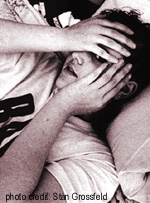
| Home | About Us | Hotlines | Activism | Presentation | Discussion | Contact | Search | |
 |
Prostitution & the Sex Trade Vednita Carter, one of the film's participants, is the executive director of Breaking Free, an organization that helps prostituted women. Their goal is to provide them the support and protection to get out of the life. Before joining Breaking Free, she worked for an organization called WHISPER that had similar goals. She has worked with thousands of prostitutes for over 11 years. As a young woman she worked as an exotic dancer and was forced to turn tricks to get out of dangerous situations in which the dancers were brought to remote bars and they had to earn money to get home. Her perspective is that prostitution and rape are profoundly related. She thinks prostitution contributes to a climate in which rape is tolerated. Do viewers agree with that perspective? In Nevada, where prostitution has been legalized, the rape rates are the 4th highest in the country. Is prostitution rape? Is prostitution good for society? What does it mean that men can pay for sex in our society? What are the real choices in sex work? How does knowing the average age (13-17) and sexual abuse history (at least 75%) of prostituted women impact the assertion that prostitution is a "career choice"? What does it mean to freely choose sex work? How does knowing that 95% of prostituted women share their money with/relinquish it to a pimp compare with your beliefs about the financial incentive in prostitution? What about the myth that prostitutes can earn significant money? In a study in the Netherlands of legalized prostitutes, their average salary was 9 Euros, then about 7$ an hour. How much do prostitutes really make in the US? In Nevada (where prostitution is legal)? Vednita insists that prostitution is a continuum of slavery. In antebellum America, society condoned the rape of slaves by their male owners as a right of property. Vednita speaks of the persistence of that injustice in terms of the demographics of prostitutes (mostly poor black women) and johns (mostly middle-class to affluent white men). What connections (if any) do you observe between race and prostitution? We are all aware that a double standard about sexuality still exists in our culture. This double standard still informs our view of the differences between the sexuality of men and women. Men are expected to want/need sex and the women who "give" sex to them are considered dirty and licentious. It becomes very difficult to discuss prostitution and sex work as an expression of women's sexual liberation because it is still so obviously a service that is in place to fulfill the sexual demands of men. Have things changed for women in the last 30 years? What do we know about even earlier attitudes? What about the movement to unionize sex workers? Who are the activists in this movement? Although there has been a lot of press about the unionization of Holland's prostitutes, only women with EU documents are able to obtain permits to work as legal prostitutes. This leaves few choices for the foreign prostitutes who often cannot afford to return to their countries. They vanish underground and work in illegal brothels or from home. They are unable to claim any of the legal protection that EU prostitutes enjoy. On the contrary, they are open to blackmail, abuse, debt burdens, and everything else that comes with illegal prostitution run by criminals and pimps. In Amsterdam, 80% of prostitutes are foreigners, and 70% have no immigration papers, suggesting that they were trafficked. (CATW Fact Book, citing Marie-Victoire Louis, "Legalizing Pimping, Dutch Style", Le Monde Diplomatique, 8 March 1997) From Diane Rosenfeld's online course: Research indicates that most women and girls working in the sex industry left their homes in search of economic opportunity or safety from physical and sexual abuse only to find more violence. The methods of control used by pimps and traffickers are similar to those used by batterers: women are denied freedom of movement, isolated, deprived of their earnings, threatened, and made dependent on drugs or alcohol. Physical and sexual violence are central to their maintenance of control. A 2001 report by the Coalition Against Trafficking in Women found: Eighty-six percent of U.S. women, and 53 percent of the international women reported being physically abused by pimps and traffickers. One-half of the U.S. women and 1/3 of the international women described frequent, sometimes daily assaults. Eighty-eight percent of U.S. women and 47 percent of international women reported psychological abuse. Ninety percent of the U.S. women and 40 percent of international women reported being sexually assaulted in prostitution at the hands of pimps and traffickers. As evidenced from the context of interviews with women, the research team believes that these findings represent underreporting of the actual violence perpetrated, especially against international women by pimps and buyers. There may be reasons for this underreporting including normalization or non-naming of the violence in their lives. FURTHER RESEARCH ON RAPEIS.ORG: Links to prostitution research and activism Links to sex trafficking research and activism OTHER DISCUSSION TOPICS: Beginnning the Discussion Controversial Debates Human Rights Dating Violence Child Sexual Abuse Pornography Legal Issues |

Teens 16 to 19 are three and one-half times more likely than the general population to be victims of rape, attempted rape or sexual assault. Source: National Crime Victimization Survey. Bureau of Justice Statistics, U.S. Department of Justice, 1996. |